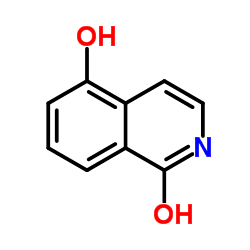Inhibitors of poly (ADP-ribose) polymerase ameliorate myocardial reperfusion injury by modulation of activator protein-1 and neutrophil infiltration.
Jennifer Kaplan, Michael O'Connor, Paul W Hake, Basilia Zingarelli
文献索引:Shock 23(3) , 233-8, (2005)
全文:HTML全文
摘要
During myocardial reperfusion injury, oxidative stress induces DNA damage and activation of the nuclear enzyme poly(ADP-ribose) polymerase-1 (PARP-1), resulting in cardiovascular dysfunction. In this study, we investigated the biological effects and the molecular mechanisms of two structurally unrelated selective inhibitors of PARP-1, 3-aminobenzamide (3-AB) and 1,5-dihydroxyisoquinoline (-DIQ), in an in vivo model of myocardial ischemia and reperfusion. Male Wistar rats were subjected to 30 min of occlusion followed by reperfusion (up to 24 h) of the left anterior descending coronary artery. In vehicle-treated rats, ischemia and reperfusion induced extensive myocardial damage and marked neutrophil infiltration (as indicated by myeloperoxidase activity). Caspase 3 was maximally activated within 15 to 30 min after reperfusion, suggesting the occurrence of apoptosis. These inflammatory events were associated with activation of the transcription factor activator protein-1 (AP-1) in the reperfused hearts. Treatment of the rats with the PARP-1 inhibitors, 3-AB or 1,5-DIQ, reduced myocardial damage, neutrophil infiltration, and caspase activation. This cardioprotection was associated with reduction of AP-1 activation. Furthermore, in in vitro cytokine-stimulated human endothelial cells, expression of intercellular adhesion molecule 1, vascular cellular adhesion molecule 1, and P- and E-selectin was significantly reduced by treatment with 3-AB or 1,5-DIQ. On the contrary, in vivo or in vitro treatment with nicotinic acid, a chemical analogue of PARP inhibitors, which lacks the ability to inhibit the catalytic activity of PARP-1, was unable to afford any protective effect and to prevent activation of AP-1. Our data demonstrate that inhibition of catalytic activity of PARP-1 may provide cardioprotection by regulating stress-induced signal transduction pathways.
相关化合物
| 结构式 | 名称/CAS号 | 分子式 | 全部文献 |
|---|---|---|---|
 |
1,5-二羟基异喹啉
CAS:5154-02-9 |
C9H7NO2 |
|
Inhibitors of poly (ADP-ribose) synthetase protect rat cardi...
1999-01-01 [Cardiovasc. Res. 41(1) , 126-34, (1999)] |
|
Prevention of the degeneration of human dopaminergic neurons...
2015-08-01 [Br. J. Pharmacol. 172 , 4119-32, (2015)] |
|
Modulation of the poly (ADP-ribose) polymerase inhibitor res...
2014-10-01 [Carcinogenesis 35(10) , 2273-82, (2014)] |
|
Disrupted ADP-ribose metabolism with nuclear Poly (ADP-ribos...
2016-01-01 [Parasit. Vectors 9 , 173, (2016)] |
|
Inhibition of poly-ADP ribose polymerase enzyme activity pre...
2014-01-01 [Wound Repair Regen. 22(5) , 666-70, (2014)] |